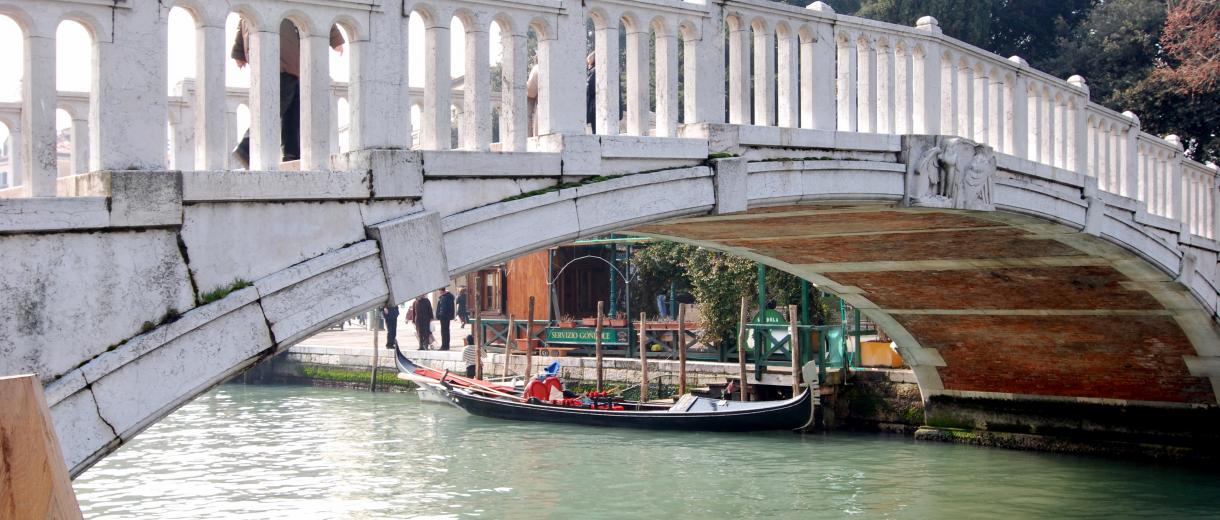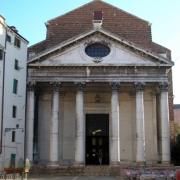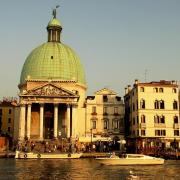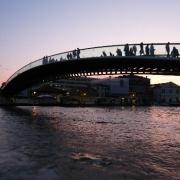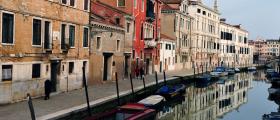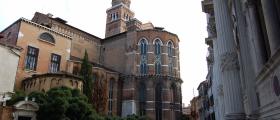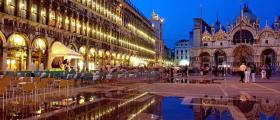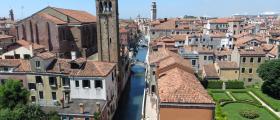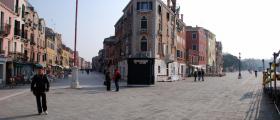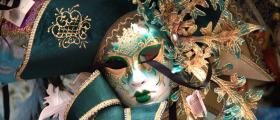Venice and its door on the mainland: the "Sestiere di Santa Croce"
The sestiere of Santa Croce is the easiest part of the city to reach, it includes the Maritime Port and Piazzale Roma (the only part of the city reachable by car).
It’s also quite close to Santa Lucia Train station. The sestiere has been deeply changed during the last 50 years, the Rio Novo has been digged, the whole Piazzale Roma rebuilt, the Constitution Bridge (aka the Calatrava Bridge) inaugurated on Sept. 11th 2008, a new transport system called People Mover is on the way: it is a mono rail train that will link the isle of Tronchetto and Piazzale Roma.
All those changes altered the artistic and historic patrimony of the area which however still retains its Venetian character and made it even more lively and populated.
The name of the Sestiere comes from the homonymous church and the annexed monastery: the church does not exist any more for it was demolished in the beginning of 800 to make room for the Papadopoli Gardens. Nowadays, only a stone column surmounted by a Greek capitol mounted on a city wall remains, it is said that in front of this capitol prisoners where tortured before being executed.
A few steps from here we find the place where the monastery of Santa Chiara was built, this one also almost completely demolished. Only few parts of it still remain, one of those is the Hotel Santa Chiara and the relative ancient wall. From there the new Constitution Bridge can be admired.
A legend says that in 1262 a peregrine knocked at the monastery door and gave the nuns a casket and a ring that they had to guard until someone else would come and show them an identical one. In change for this the nuns would hand the casket in to this person. No one came for more than 300 years, and finally, after a tide that miraculously spared it, the nuns decided to open the casket to see what was in there. They found a nail and a parchment which explained that the nails were recovered by Saint Luigi King of France (who died on a crusade) from Jesus Christ cross. The nail was venerated in the monastery until 1830 and then was moved to San Pantalon Church.
Along the Grand Canal, halfway between the Calatrava and the Scalzi Bridge we find the San Simeon Piccolo's Church, so called in order to distinguish it from the church of San Simeon Grando, which, despite the meaning of its Italian name (“grando” = big) it is way smaller.
This is due to the restoration of the church during the 700 but the name remained as well as the disproportion of the dome. The legend says that Napoleon, arrived in Venice by “train”, said: I’ve seen many churches without a dome but never a dome without a church.
Several other corners of the sestiere are involved with tales, legends and curiosities of all sorts, many of them of gruesome nature. An example is the Riva Di Biasio, faced on the Grand Canal. In the year 500 on this foundation there was a landlord whose name was Biasio, well know for his “sguazzetto”, a sort of meat sauce, tasty to the point that the majority of the citizens were attracted by it. One day, one of his guests denounced him to the authority because he found a phalanx of a child in his soup. Police discovered that he was using children-meat to prepare his famous recipe!!!
His hands where amputated. He was tortured and then beheaded in Saint Mark’s Square between the two big columns, as a warning to the people. Parts of his body were hanged in the 4 angles of the city, his inn and his house demolished.
A little bit ahead towards the eastern side, there is a sculpture of a beheaded head on the wall of the church of San Zan Degolà in memory of the event.
Close to this area there is also the Fondaco dei Turchi , now base of the Museum of Sciences and Natural History. The building, facing the Grand Canal, is extraordinarily beautiful. As all the “fondaci” it was built as the focal point for the trade (Turkish in this case) in the city of Venice.
We are now in the heart of the Sestiere di Santa Croce, Campo “San Giacomo Dell’Orio”. This area is quite attractive, nice, lively and populated by many Venetians.
To be mentioned is the Palazzo Pemma XVIII century, its jambs are tilted on a way that his owner, a Jew, could not see the Church of San Giacomo Dall’Orio which is in the middle of the square.
The church is one of the oldest of the city and it is well worth a visit. Erected in the IX century and rebuilt in XIII Century, it is characterized by a room shaped as a ship keel and by operas by various artists such as Lorenzo Lotto, Paolo Veronese and Jacopo Palma Il giovane.
Another church that deserves a visit is the one of San Nicola da Tolentino, (so called dei Tolentini), just a few steps from Piazzale Roma, the Church was bombed and partially destroyed by the Austrian army in 1849.
In memory of this episode a cannonball, now engraved on the wall of the church, knocked down the dome and fell in front of the main Altar. The dome doesn’t exist any more.
On the inside there are many paintings and the corpse of Doge Francesco Morosini.
The Monastery of the Church is now seat of the I.U.A.V., University of Architecture of Venice.

